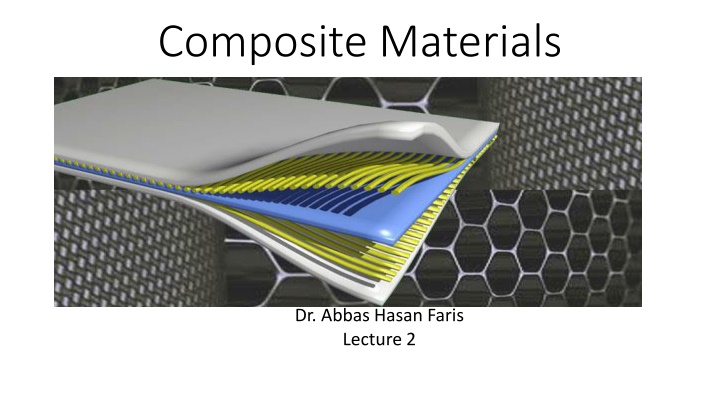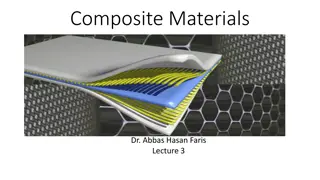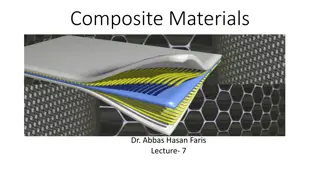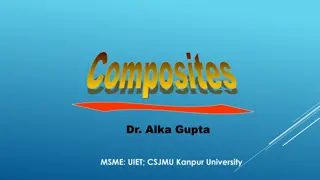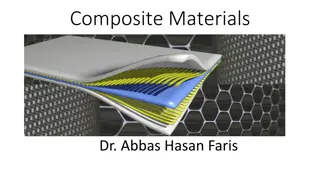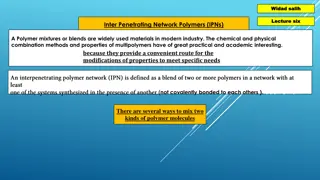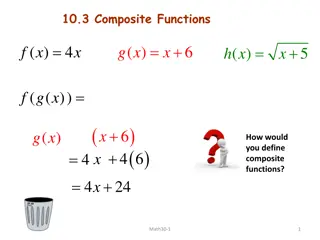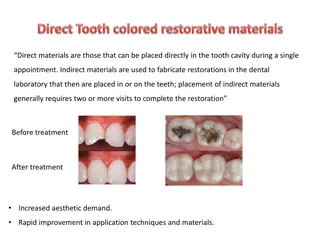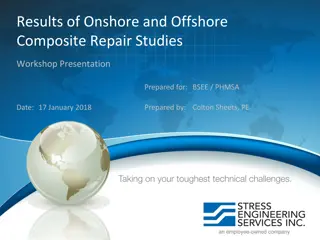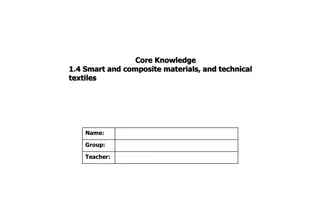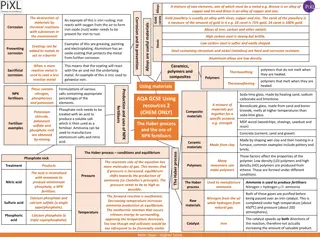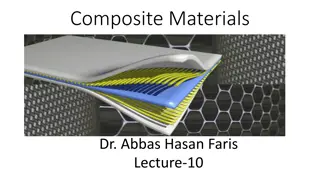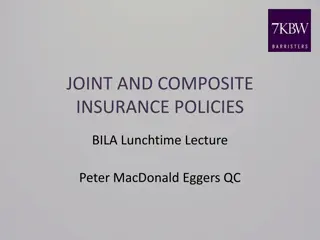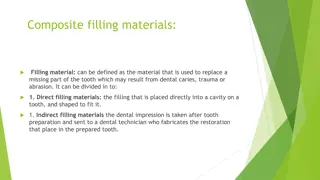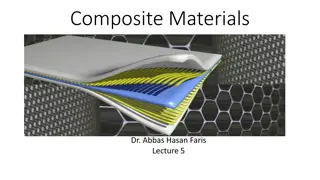Composite Materials in Industries
Composite Materials, Advanced Composites, Polymer Matrix, Natural Composites, Manufacturing
Download Presentation

Please find below an Image/Link to download the presentation.
The content on the website is provided AS IS for your information and personal use only. It may not be sold, licensed, or shared on other websites without obtaining consent from the author.If you encounter any issues during the download, it is possible that the publisher has removed the file from their server.
You are allowed to download the files provided on this website for personal or commercial use, subject to the condition that they are used lawfully. All files are the property of their respective owners.
The content on the website is provided AS IS for your information and personal use only. It may not be sold, licensed, or shared on other websites without obtaining consent from the author.
E N D
Presentation Transcript
Composite Materials Dr. Abbas Hasan Faris Lecture 2
Advanced composites are composite materials that are traditionally used in the aerospace industries. These composites have high performance reinforcements of a thin diameter in a matrix material. Examples are graphite/epoxy, Kevlar /epoxy, and boron / aluminum composites. These materials have now found applications in commercial industries as well. Combining two or more materials together to make a composite is more work than just using traditional monolithic metals such as steel and aluminum. 2
Polymer Matrix Composites What are the most common advanced composites? Graphite/Epoxy Kevlar/Epoxy Boron/aluminum
Examples of Natural Composites Wood Cellulose Fibers Lignin Matrix Bones Collagen Fibers Mineral Matrix
To manufacturing composite materials should be 1. Combination of materials should result in significant property changes 2. The content of the constituents is generally more than 10% 3. In general, the property of one constituent is much greater ( 5) than the other In some cases, a third ingredient must be added to achieve the bonding of primary and secondary phases Called interphase, this third ingredient can be thought of as an adhesive.
Interphasemaybecomposedof a solutionoftheprimaryandsecondary phasesattheirboundarybydiffusion
Why do you need composite materials? Enhanced desired properties! What are these desired properties? Strength Stiffness Toughness Corrosion resistance wear resistance Reduced weight Fatigue life Thermal/Electrical insulation and conductivity Acoustic insulation Energy dissipation Attractiveness, cost, .. Tailorable properties
-Stiffness is defined as the resistance of a material to deflection. - Strength is defined as the stress at which a material fails. - Fatigue resistance is the resistance to the lowering of mechanical properties such as strength and stiffness due to cyclic loading, such as due to take-off and landing of a plane, vibrating a plate, etc. -Impact resistance is the resistance to damage and to reduction in residual strength to impact loads, such as a bird hitting an airplane or a hammer falling on a car body. 11
-Thermal conductivity is the rate of heat flow across a unit area of a material in a unit time, when the temperature gradient is unity in the direction perpendicular to the area. -Corrosion resistance is the resistance to corrosion, 12
Reinforcement increases the mechanical properties of the composite. It provides strength and stiffness to the composite in one direction as reinforcement carries the load along the length of the fiber. Reinforcement can be fibers, fabric particles, or whiskers. these reinforcements are fundamentally used to increase the mechanical properties of a composite. The main purpose of the reinforcement is to 1- Provide superior levels of strength and stiffness to the composite. 2- Reinforcing materials (graphite, glass, SiC, alumina) may also provide thermal and electrical conductivity, controlled thermal expansion, and wear resistance in addition to structural properties. 3- The most widely used reinforcement form in high-performance composites is fiber tows (untwisted bundles of continuous filaments). 4- Fiber monofilaments are used in PMCs, MMCs, and CMCs; they consist of a single fiber with a diameter generally 100 m. 5- In MMCs, particulates and chopped fibers are the most commonly used reinforcement morphology, and these are also applied in PMCs. 6- Whiskers and platelets are used to a lesser degree in PMCs and MMCs.
Regarding the tensile strength behavior of the composite, it is given by the shape, concentration, and orientation of reinforcement. The shape of reinforcement particles can be considered approximately as 1. a sphere (the powder form of reinforcement) 2. a cylinder (fibers). Their size and distribution then determine the texture of the composite. e.g., glass fibers , carbon fibers, ceramic fibers. size of the reinforcing phase, expressed in terms of volume or the quantity of weight. It is one of the most important parameters that affect the properties of the composite material. The orientation of the reinforcing phase affects the isotropy of the system. If the reinforcing particles have the shape and dimensions in all directions about the same (for example powders), the composite behaves basically as an isotropic material, therefore its properties are the same in all directions. On the contrary systems reinforced with cylindrical reinforcement (fibers) show an anisotropy of properties.
Simply put this means that the mechanical properties of the material depend on the direction. Isotropic materials are materials whose properties remain the same when tested in different directions. Isotropic materials differ from anisotropic materials, which display varying properties when tested in different directions. Common isotropic materials include glass, plastics, and metals. Isotropic refers to the properties of a material that is independent of the direction whereas anisotropic is direction-dependent. These two terms are used to explain the properties of the material in basic crystallography.
the reinforcement is usually a fiber or a particulate. particulate composites have dimensions that are approximately equal in all directions. they may be spherical, platelets, or any other regular or irregular geometry. particulate composites tend to be much weaker and less stiff than continuous-fiber composites, but they are usually much less expensive. particulate reinforced composites usually contain less reinforcement (up to 40 to 50 volume percent) due to processing difficulties and brittleness.
Reinforcements Types Reinforcing phase, is in the form of: fibers, Whiskers, Sheets & particles and is embedded in the other materials (the matrix phase).
Composites Reinforcement c: continuous fibers, d: sheet laminate According a: to Type whiskers, of particles, b: b a C d
The matrix is basically a homogeneous and monolithic material in which a fiber system of a composite is embedded. Matrix is completely continuous. The matrix provides a medium for binding and holding reinforcements together into a solid. It offers protection to the reinforcements from environmental damage, serves to transfer load, and provides finish, texture, color, durability, and functionality. Matrix :- It is the material that work to bind the reinforcing material together in order to make a composite material that can carry loads or stresses . The matrix combines the individual reinforcement particles, protecting them against external influences. The basic function of the matrix is to transmit the external load onto the reinforced phase.
Fo the matrix, 1. a good bond strength with the reinforcing phase material (i.e. perfect wettability without chemical interaction at the interface of the matrix and reinforcement) is required. 2. Among other requirements for the matrix, a low weight is commonly included. In comparison with the reinforcement phase, a matrix has generally lower strength and greater plasticity. It is also called medium , it is may be metal , polymer or ceramic.
What are the advantages of using composites over metals? Monolithic metals and their alloys cannot always meet the demands of today s advanced technologies. Only by combining several materials can one meet the performance requirements. In many cases, using composites is more efficient. For example, in the highly competitive airline market, one is continuously looking for ways to lower the overall mass of the aircraft without decreasing the stiffness* and strength of its components. 24
This is possible by replacing conventional metal alloys with composite materials. Even if the composite material costs may be higher, the reduction in the number of parts in an assembly and the savings in fuel costs make them more profitable. Composites offer several other advantages over conventional materials. These may include improved strength, stiffness, fatigue and impact resistance, thermal conductivity, corrosion resistance ,etc. 25
Advantages and disadvantages of composites The advantage of composites as structural materials is to obtain a material of higher strength, toughness, and stiffness, but also a higher resistance compared to conventional materials. In addition, with a suitable combination of components, we can also obtain a composite of specific properties (thermal, electrical, optical). The disadvantage of composite materials, in comparison with traditional materials, is their difficult workability and relatively higher price. Stiffness is how well a material resists deformation. Toughness is the ability of a material to absorb energy before failure.
Thus, to measure the mechanical advantage, the (E/) ratio is calculated and is called the specific modulus (ratio between Young s modulus* (E) and the density ( ) of the material). The other parameter is called the specific strength and is defined as the ratio between the strength ( ult) and the density of the material ( ), that is,
Young's modulus is the slope of the linear part of the stress-strain curve for a material under tension or compression. E ... The Young's modulus (E) is a property of the material that tells us how easily it can stretch and deform and is defined as the ratio of tensile stress ( ) to tensile strain ( ). Where stress is the amount of force applied per unit area ( = F/A) and strain is extension per unit length ( = dl/l). The basic difference between stress and strain is that stress is the deforming force per unit area, While strain is the apparent change in the shape, volume, or length of an object caused due to stress is called strain. The strain has no unit.
Why Composites over Metals? How is the mechanical advantage of composite measured? E Specific modulus = , ult Specific strength = . where = Young' Modulus s E = Density = Ultimate Strength ult
Specific Strength vs. Year 10 Aramid Fibers, Carbon Fibers 6) in 8 Specific Strength, (10 6 Composites 4 2 Wood, stone Bronze Cast Iron Steel Aluminum 0 1400 1500 1600 1700 1800 1900 2000 Year
Table 1.1. Specific modulus and strength of typical fibers, composites and bulk metals Specific Gravity 1.8 Young s Modulus GPa 230 Ultimate Strength MPa 2067 Specific Modulus GPa-m3/kg MPa-m3/kg 0.13 Specific Strength Material Units Graphite 1.1 Unidirectional Graphite/Epoxy 1.6 181 1500 0.11 0.94 Cross-Ply Graphite/Epoxy 1.8 96 373 0.060 0.23 Quasi-Isotropic Gr/Epoxy 1.8 70 276 0.043 0.17 Steel 7.8 207 648 0.026 0.083 Aluminum 2.6 69 276 0.026 0.106
Composites Have Distinct Advantages Over Metals. Too, There Are Drawbacks Or Limitations In Using Them. Drawbacks And Limitations In Use Of Composites Include: High cost of fabrication of composites is a critical issue. For example, a part made of graphite/epoxy composite may cost up to 10 to 15 times the material costs. Mechanical characterization of a composite structure is more complex than that of a metal structure. Unlike metals, composite materials are not isotropic, that is, their properties are not the same in all directions. 33
Therefore, they require more material parameters. For example, a single layer of a graphite/epoxy composite requires nine stiffness and strength constants for conducting mechanical analysis. Repair of composites is not a simple process compared to that for metals. Sometimes critical flaws and cracks in composite structures may go undetected. Composites do not have a high combination of strength and fracture toughness compared to metals. Composites do not necessarily give a higher performance in all the properties used for material selection. 34
